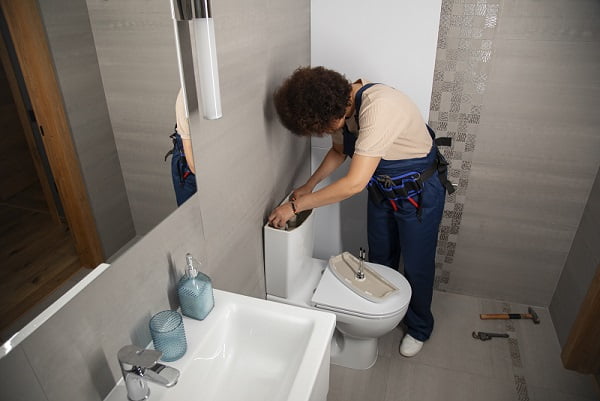Bathroom flooding can be a homeowner’s nightmare as it may cause a lot of damage and hamper daily activities if not taken care of at the right time. Be it burst pipes, broken appliances, or clogged drains – water damage from all these elements would call for proper and effective care to restore business in the bathroom as soon as possible. In this detailed guide, we will explore typical bathroom flooding causes, how to avoid them, as well as vital cleanup tips to help you get it all sorted out.
Causes of Bathroom Flooding:
Leaking Pipes:
A leaking or a burst pipe is a double-edged sword that causes bathroom flooding. Upon the running of time, either through corrosion, aging, or even external factors, their structural integrity tends to diminish and leaves cracks or holes that the water could escape from. Regular checks should be done on them and repair works done in good time to look for ways to minimize the damage in the bathroom.
Faulty Appliances:
Malfunctioning appliances like washing machines, water heaters, and dishwashers either in or around the bathroom can also bring about flooding. The appliances have connecting and hose pipes that may wear out, break up, or fail hence leading to spillage of water. Regular maintenance and inspection for malfunctioning parts would go a long way to avoid eventualities of such nature.
Clogged Drains:
Drains collect hair, and when mixed with soap suds and other waste products, the drain will eventually clog up, and water is backed up, which ends up flooding the bathroom. Drain cleaning using the right tools or chemicals may save the user such embarrassment and ensure smooth drainage.
Toilet Problems:
A faulty toilet is among the major problems that can bring flooding into the bathroom. Overflow may also come as a result of a faulty flapper, fill valve or even a clog in the drain pipe. As such, quick intervention is necessary to curb more damage from happening and also prevent further contamination of water.
Prevention Tips:
Regular inspections should be made:
Regularly check your bathroom plumbing and fixtures. Look out for leakages, rusting as well as wearing out. Attending to small issues at the initial stages will deter larger issues lately.
Maintenance:
Periodically maintain appliances like water heaters and washing machines. Check hoses and connections for wear and replace them when required. These small things may save you from sudden property loss.
Leak Detectors:
Install bathroom leak – detectors to help you monitor any leakage of water and make a prompt alarm so that you can take immediate action before the water causes great destruction.
Monitor Water Pressure:
This puts stress on the pipes and can cause them to endure additional strain from leakages or bursts. Monitor water pressures with a pressure gauge and reduce it if it is above acceptable limits.
Clean-Up Work: Safety Guidelines
Begin the cleaning process by first ensuring it is safe to access the water-logged area. Switch off the power supply to that part of the house to rule out the possibility of electric shock.
Pump the Water Out:
Remove all standing water with a wet/dry vacuum or buckets. The longer stagnant water remains, the greater the chance of causing further severe damage.
Drying Completely Out:
After eliminating the standing water, make sure that the place is well-dried. Open windows use fans, and maybe apply the use of dehumidifiers to facilitate drying. Moisture provides a conducive environment for mold growth, so fast and effective drying is required.
Disinfect and Clean:
Clean together with sanitizing the affected surfaces using disinfectants. Floodwater can be contaminated and, therefore, bacteria need to be killed for there is no health risk.
Check and Repair:
Assesses the damage and identifies whether it is a structural problem or a plumbing problem. Fixes the plumbing problem if any and repairs or replaces the drywall, flooring, or any damaged surface that the water has contacted after removing stagnant water.
Frequently Asked Questions (FAQs) on Bathroom Flooding
What generally causes a bathroom to be flooded?
Bathroom flooding can be due to many other causes including leaking pipes, appliances that are not functioning properly (such as issues with the washing machine or water heater), clogged up drains, and even problems with the toilet such as overflow or leak.
What steps do I need to take to prevent the bathroom from getting flooded?
Preventive measures can include periodic inspection of plumbing and appliances, effective maintenance of appliances, installation of leak detectors, monitoring of the water pressure, and immediate elimination of minor problems.
There is a leak or broken pipe in the bathroom — how to be?
Turn off the water supply to the area immediately affected, and if necessary, use towels or buckets to contain the water. Call in the professionals to repair or replace the damaged pipe.
Any telltale sign of a flooding possibility in the bathroom?
Surely, signs can be water stains or walls and ceilings that are discolored or smell musty. Further slow sinks or showers draining, as well as pipe strange sounds or a larger compared to the usual water bill, could be signals for plumbing issues.
How can I cope with the bathroom that has flooded?
Begin by turning off the electrical power supplying the affected region. Get rid of standing water using a wet/dry vacuum and dry out flooring and area with fans or dehumidifiers. Cleanse all surfaces, and carry on with the cleaning processes for prevention of mold growth. Assess to confirm any structural damage or ruined plumbing.
Can I raise a clogged bathroom drain?
Yes, with minor blockages, you can attempt to raise it by plunging or using a drain snake. If the problem doesn’t budge and gets grumpier, maybe you should consider using chemical drain cleaners or call for professional plumber services.
Shall I claim my insurance for bathroom flooding?
It depends on the damage and your insurance. You need to speak with your insurance regarding the situation, take photos of the damage, and keep records in case you incur expenses for cleaning and fixing it.
Conclusion:
Flooding in your bathroom for instance can be quite stressful but with proper response and cleaning fast enough and systematically could go a long way in minimizing the damage cost. Prompt maintenance measures and taking time with preventive procedures in addition to quick cleaning could prevent disastrous results of water damage from flooding your household. Thus, by being proactive and by staying alert you should be able to protect your bathroom, thus saving yourself from the threat of flooding.
Divine Wordsmith is a spiritual guide and writer, weaving tales of wisdom and insight to inspire inner growth and connection to the divine. Join the journey of self-discovery and enlightenment through the transformative power of words.




